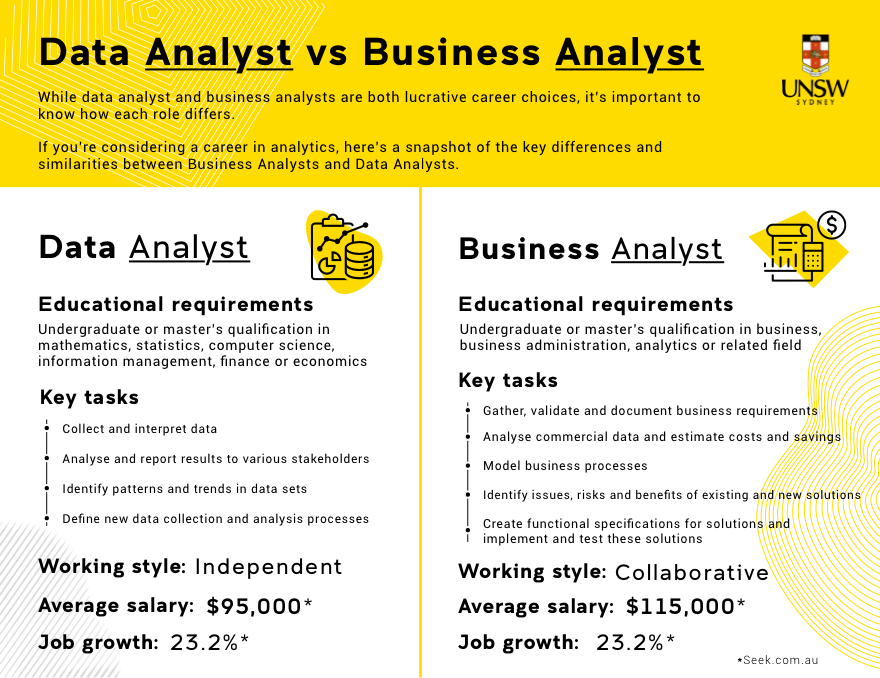Data analyst vs business analyst: What’s the difference?

Those who choose to boost their careers by earning a Master of Analytics are often from or heading into the data analytics or business analytics fields. For both careers, a close understanding of data analytics is vital and yet in most organisations, their roles and responsibilities are quite different.
On the most basic level, a business analyst uses data and information to make important and often strategic business decisions. A data analyst, on the other hand, gathers and analyses data and uses this data to identify trends and insights.
These differences are just the tip of the iceberg, though. In order to pursue a career in this field, it’s important to know how the responsibilities differ when it comes to data analysts vs business analysts. It’s also important to understand what information is required to make a choice between the two.
Data analyst vs business analyst: What are they?
Data analysts and business analysts utilise data, and both roles deliver critical business insights. But that’s where the similarities end.
Here is a detailed breakdown of the responsibilities of a business analyst versus the responsibilities of a data analyst.

What is a business analyst?
The role of a business analyst, as it is most commonly defined, involves solving a current or future problem for an organisation - often with implementing technology as part of the solution. Rather than managing the broader organisational strategy, as might be the role of a CEO, a business analyst typically focuses closely on a specific project or challenge.
In developing a response to that challenge, the business analyst facilitates change. While their role may not involve implementing that change (although it often does), the result of the business analyst’s work always involves some form of change.
What might that change be? It can involve any and every aspect of business. Perhaps it’s around performance management in a certain part of an organisation, improving fulfilment processes, enhancing customer experience and consistency, expanding into a new market, freeing up staff by introducing automation, new product development or countless other business challenges.
Often the role of a business analyst involves determining, designing and implementing new IT systems to improve functional efficiencies and achieve certain goals. This means they often work closely and collaboratively with IT teams.
Their job involves developing a thorough understanding of what the business does and knowing what role their project plays in the broader organisational strategy. To analyse needs and develop a new business case, they must discuss issues with numerous stakeholders, develop and test various solutions and then present their findings to their internal client – whether that be an executive or the board.
On any given day, business analysts may do the following:
- Gather, validate and document business requirements
- Analyse commercial data (including budgets and sales results) and estimate costs and savings
- Model business processes
- Identify issues, risks and benefits of existing and new solutions
- Create functional specifications for solutions and implement and test these solutions
For assistance with these responsibilities, they can expect to harness the power of data analysis to develop their knowledge and inform decisions.
It is not uncommon for those who have worked purely as data analysts to move into a business analyst role, as it typically broadens their responsibilities and often takes them into a more senior position. Business analysts also come from the fields of project management, software development and general management.
What is a data analyst?
While the business analyst works across various organisational functions and problems, data analysts typically work exclusively with data.
Data analysts use the many powerful tools and techniques at their disposal to figure out how the available data, in its many forms, can best be utilised to help the business reach its strategic goals.
Data analysts begin by defining a question or a problem. A clear definition helps them figure out which data sets are absolutely necessary and which are a distraction.
They then go about gathering this data, ensuring that it is in a consistent format and then culling it to further remove erroneous or unnecessary information. Next, they process the data to reveal patterns and trends, causes and effects or predictions and reasons – anything that will help the business answer the original question and make better decisions about how to move forward.
On any given day, data analysts may do the following:
- Collect and interpret data
- Analyse and report results to various stakeholders
- Identify patterns and trends in data sets
- Define new data collection and analysis processes
Data analysts benefit from knowing general business practices and processes as well as from knowing the strategy and goals of their employer or client organisation.
The difference between a data analyst and a business analyst
A number of differences between data analysts and business analysts can shed light on what makes each unique.
Different approaches to IT systems
The two professions – business analyst and data analyst – can be said to have different approaches to IT systems.
For a business analyst, an IT system is something that they work with or work within. A business analyst may discover a need for a new IT system or help identify issues with an existing system or the processes that surround it.
Data analysts gather data from IT systems and then interpret and analyse it to yield critical business insights.
However, as data becomes central to every business decision, the role of the business analyst relies more heavily on data analytics. This means that, to become an exceptional business analyst, a candidate should already be an exceptional data analyst.
The difference between the two roles depends on how the organisation itself treats the roles, understands the meaning of data and desires positive change.
Collaboration versus independence
Business analysts and data analysts work in different ways. Specifically, the role of business analysts requires them to be more collaborative, whereas data analysts are more likely to be independent.
This works as follows. By their very nature, business analysts are required to work with a large range of stakeholders from every function within the business in order to produce the most well-rounded analysis.
Data analysts are not required to do this, as their role is more independent. Typically, they work independently with data and then at a later point, they might present their findings to other functions or stakeholders within the business.
Data analyst vs business analyst: Salaries, job outlook and educational requirements
Despite their differences, data analyst and business analyst careers can both be rewarding and well -paid. Here is a breakdown of the differences in average salaries, job outlooks and educational requirements:
Data analyst
- Average salary: According to Seek, the median salary for a data analyst in Australia is $95,000 as of August 2023.
- Job outlook: According to Seek, the future outlook for data analysts is 23.2 per cent over the next five years.
- Educational requirements: To work as a data analyst, graduates will need an undergraduate or a master’s degree in mathematics, statistics, computer science, information management, finance or economics.
Business analyst
- Average salary: According to Seek, the median salary for a business analyst in Australia is $115,000 as of August 2023.
- Job outlook: According to Seek, the future outlook for business analysts is 23.2 per cent over the next five years.
- Educational requirements: To work as a business analyst, graduates will need an undergraduate or a master’s degree in business, business administration, analytics, technology or a related field.
How data analysts and business analysts work together
It’s critical that data analysts and business analysts collaborate in order to achieve the best outcomes for the business.
Business analysts can help data analysts succeed and vice versa. Professionals in each domain can make each other’s jobs a lot easier. They may be able to help automate each other’s tasks. They could possibly provide unique and unexpected points of view on an issue or be able to identify different ways to come up with the specific information required to solve a problem.
Moreover, both roles require exceptional communication skills in order to seek and provide vital business information before, during and after a project.
A business analyst will have greater interaction with people and a data analyst will require a stronger understanding of matters that relate to data science.
Data analyst vs business analyst: What will you do?
Whether you choose to be a data analyst or a business analyst, or you oscillate between the two, one thing is for sure: there are ample career opportunities within each field. Yet to succeed, it’s important to have a solid educational foundation in analytics.
Learn more about UNSW’s Master of Analytics Online. Get in touch with our enrolment team at 1300 974 990.









